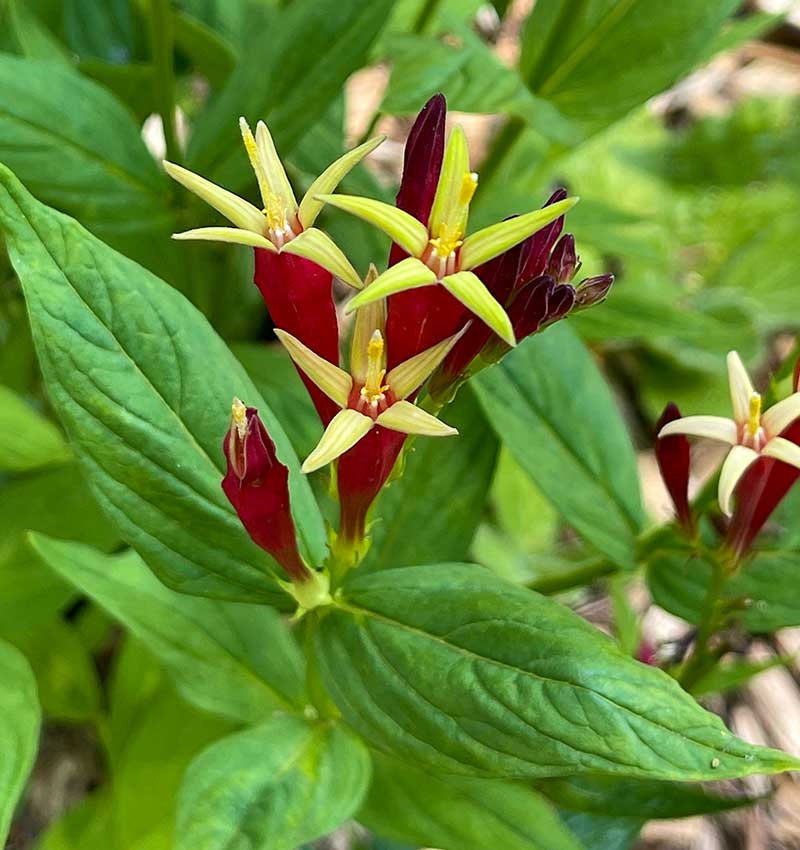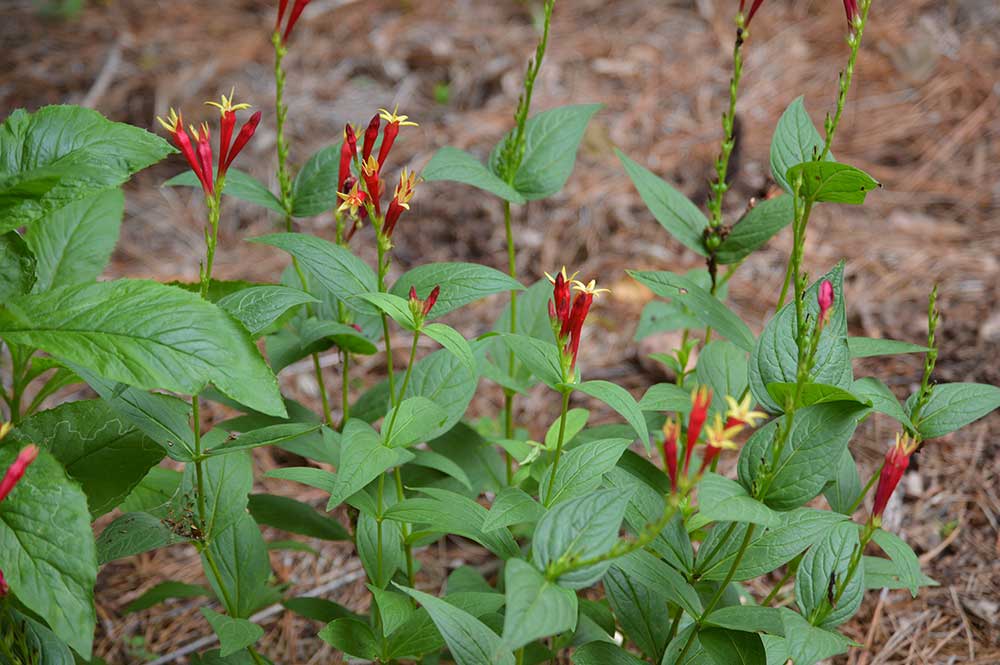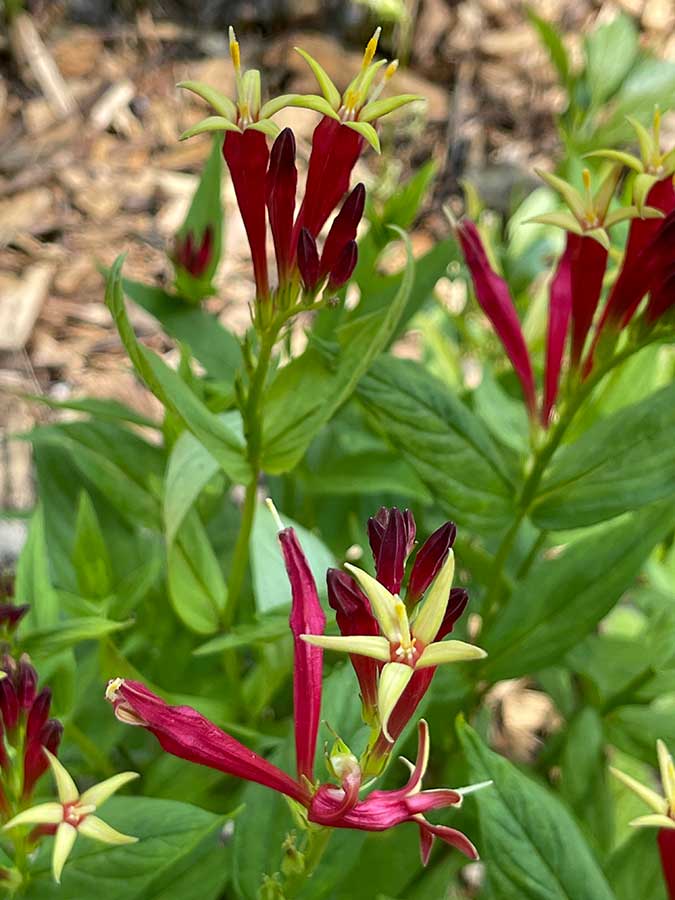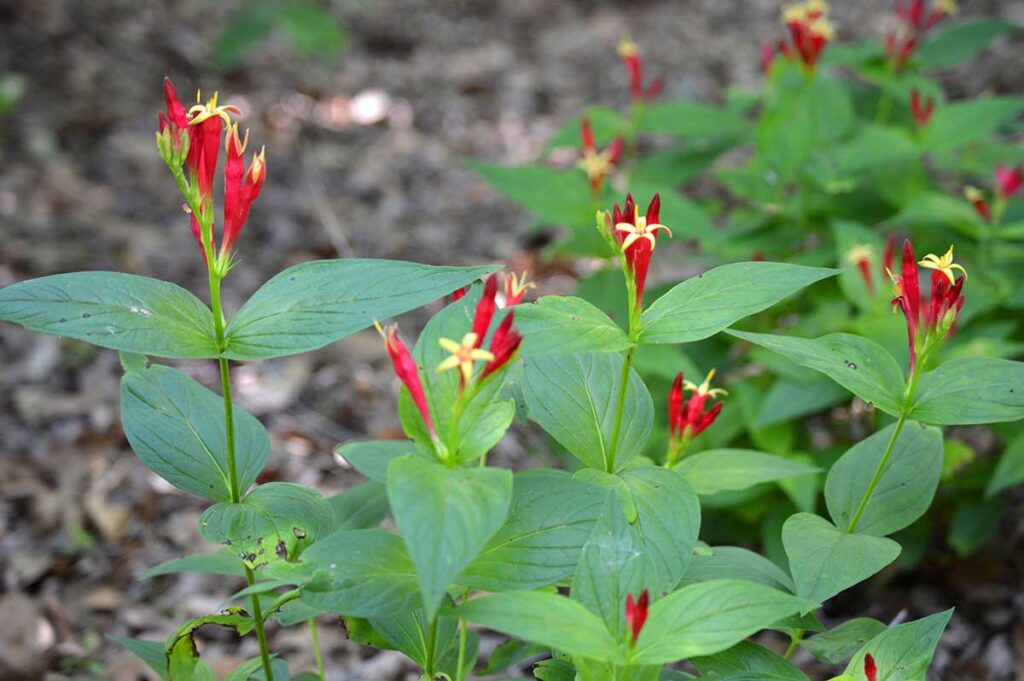
One of the prettiest wildflowers you can find in the woods is Indian Pink, Spigelia marilandica. This native plant has bright red tubular flowers with a yellow interior that ends in a 5-pointed star. The rich, red color really stands out making it a great flower for the shady areas of your garden.
Where Does Indian Pink Grow?
Indian pink is also known as woodland pinkroot or worm grass. This perennial flowering plant can be found in 16 southeastern states from Texas east to the Carolinas and northward to Oklahoma, Virginia, and Maryland.
This plant is hardy in USDA zones 5a to 9a and is typically found growing in forests, along the banks of shaded streams, or at the edge of wooded areas.
Indian Pink Characteristics
This native perennial plant grows in clumps (clumping growth form) and it spreads by rhizomes. It isn’t an aggressive spreader though and won’t invade other areas.
It can be 12 to 28 inches tall and have a width of a foot or two as well. The roots of the plant are yellow in color.
The leaves are arranged alternately on the stem and are ovate to lance-shaped. The plant is deciduous and loses its leaves in the winter.

Flowering starts in spring and continues through summer. If you dead head the blooms, you can extend the blooming season. You may even get a second bloom in the early fall.
The pollinated flowers turn into capsules in the summertime. Each capsule holds several seeds. As they ripen, they will burst open and fling seeds in every direction.
This plant is poisonous and in high quantities can be lethal. Do not ingest it!
How to Grow Indian Pink Flowers
To get the most blooms and to have a healthy plant, place Indian pink in a location that receives no more than 2-6 hours of sun. This native wildflower is perfect for part-shade to full-shade gardens.
Indian pink does best in well-drained soil with lots of organic materials. However, it will tolerate wet soils. This plant is also drought tolerant!
This is a great low-maintenance native flowering plant for your shade garden
Keep your plants watered when you first transplant them, but you should be able to reduce watering (or just rely on rain) as the plant matures. If you have planted your Indian pinks near trees, you may need to continue to provide supplemental water. The trees will compete with the plants for water.
Dead head the flowers from each plant to get more and continuous blooms. It blooms from the bottom of the stem to the top, so keep an eye out for spent blooms to snip off.
Overall, this is a great low-maintenance native flowering plant for your shade garden.
How to Propagate Indian Pink

There are several methods to propagating Spigelia marilandica in your garden. You can collect the seeds, separate the plants, or make stem cuttings.
Collecting Seeds
To collect seeds, you can place small, netted bag over capsules that are still green. This will allow you to capture the seeds as the pods open when they ripen. You can also pick the capsules when they are still green and put them in a brown paper bag to ripen and open. You should plant the seeds as soon as possible after they are expelled from the capsule.
Dividing Plants
Divided your plants in spring or fall. Use a sharp knife to cut the roots of the plants apart. You can divide the plants in spring and immediately plant them or wait until fall to divide the plants. If you separate the plants in early fall, it is likely you can plant them back into the soil and they will develop enough root systems to survive a frost. If you separate the plants in late fall, you should plant them in containers and keep them from freezing over the winter.
Taking Cuttings
Take cuttings from the tips of the plant with no flowers, dip the cut tip into rooting hormone and place in well-draining soil in a pot. Place the pot in a shaded area for rooting and keep the soil moist, but not overly wet. Overwinter the cuttings in a warm location to prevent freezing and plant the following spring.
For very detailed instructions on propagation and resources for more information on test cases, visit the Nursery Crop Extension Research of UK.
Wildlife Uses of Indian Pink
Indian pink is deer resistant, so it’s a great choice for those of us planting gardens in areas with hungry deer.
If you wish to attract butterflies and hummingbirds in your shade gardens, Indian pink is a great choice! Hummingbirds and butterflies both feed on the nectar produced by the tubular flowers.
Indian Pink – Spigelia marilandica
Native shade plant with red, tubular flowers
USDA Zones
Hardy in USDA zones 5b, 6a, 6b, 7a, 7b, 8a, 8b, 9a, 9b
Native Range
Native to Texas, Oklahoma, Louisiana, Mississippi, Alabama, Georgia, South Carolina, North Carolina, Florida, Tennessee, Virginia, Maryland, Kentucky, Illinois, Missouri, Arkansas
Water Requirements
Wide range of moisture levels, from average to moist soils
Drought tolerant
Wildlife Value
Deer resistant
Hummingbird & butterfly attractant
Bloom Time
Spring to Summer
Can be extended with dead heading
Soil Types
Well-drained, rich in organic materials
Plant Type
Perennial
Deciduous
Herbaceous
Plant Height
1 – 2 feet
Light Requirements
Part-shade to full shade (2-6 hours sunlight)

